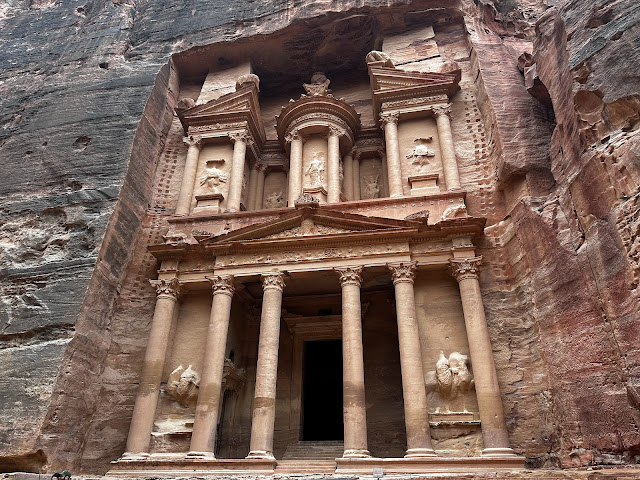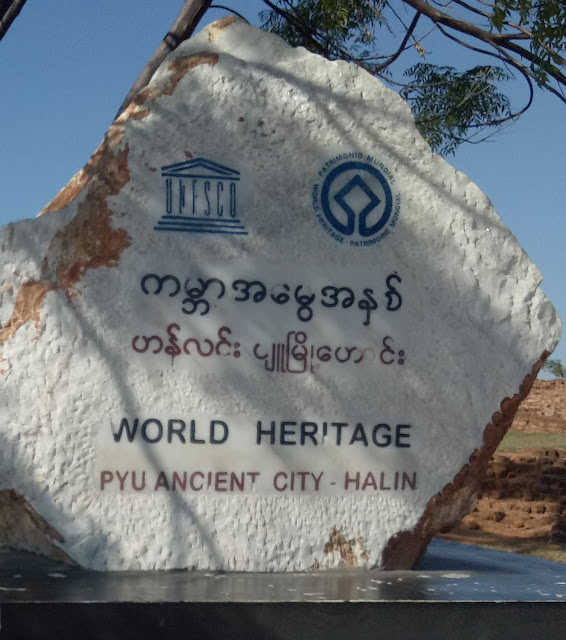Petra is a historical
archaeological city located in Southern Jordan. The capital city of the
Nabataean Kingdom (3rd Century BCE – 106 CE) during the 2nd
Century BCE, Petra was designated as a UNESCO World Heritage site in 1985 CE. Famous
for the city’s Rock-cut architecture, Petra was designated as one of the “New 7
Wonders of World” in 2007 CE.
While "Al-Khazneh"(https://ancientjourneys.blogspot.com/2023/12/al-khazneh-treasury-at-petra.html) and "Ad Deir"(https://ancientjourneys.blogspot.com/2023/12/ad-deir-monastery-at-petra.html)
are the most recognizable structures within Petra, the archeological site
houses many more impressive architectural marvels, including the Obelisk Tomb,
Bab as-Siq Triclinium, the Djinn Blocks(https://ancientjourneys.blogspot.com/2024/08/the-obelisk-tomb-bab-as-siq-triclinium.html),
the Theater, The Royal Tombs, The Great Temple and the Qasr al-Bint.
The Theater in Petra has been designed
with three seating rows which are separated by passageways. The seven stairways
in the structure lead to an auditorium which is estimated to be able to accommodate
four thousand spectators. The Theater is the only one in the world to have been
carved into a rock.
 |
The Petra Theater
|
Across the theater lies the four
rock cut structures carved into stone named “The Royal Tombs”. The four structures
are named the Urn Tomb, the Silk Tomb, the Corinthian Tomb, and the Palace
Tomb. Estimated to have been constructed around 70 CE, the Urn Tomb was
reconstructed as a Byzantine Church in 446 CE. Named after the rich color of its’
sandstone, the Silk Tomb dates back to the first half of the 1st
Century CE. The Corinthian Tomb which was constructed approximately between 40
CE and 70 CE has some similarities with "Al-Khazneh" (the Treasury), even though it has severely eroded over time. The Palace Tomb, which dates back
to the 2nd Century CE is believed to have been used for either
banqueting or funerary functions. |
The Royal Tombs of Petra
 | The Corinthian Tomb
|
 | | The Urn Tomb |
|
The Great Temple Complex in Petra,
which is estimated to cover an area of 7560 square meters lies south of the Colonnaded
Street at Petra. The construction of the temple is attributed to the Nabataean
King Aretas IV (reign: 9 BCE - 40 CE). A rectangular complex aligned on a
northeast-southwest axis, whether the complex actually served as a religious building
or whether it functioned as an administrative building remains unclear. The
original building is estimated to have been at least 18m in height.
 |
| The Great Temple of Petra |
The Qasr al-Bint is considered to
be the most important temple in Petra. The current structure is believed to
have been constructed between the 1st Century BCE and the end of the
1st Century CE, on the remains of an earlier monument. The temple’s later
constructions are dated from 106 CE to the late third century CE. At some point
between approximately 268 CE and 272 CE, most likely during the invasion by the
Palmyrene Empire (a short-lived breakaway state from the Roman Empire which
existed from 260 CE to 273 CE, which used the city of Palmyra in modern day
Syria as its’ capital), it was vandalized and burned down. Qasr al-Bint was
dedicated to “Dhu-shara”, the main Nabataean deity.
 |
| Qasr al-Bint |
 |
| Qasr al-Bint |
A number of artifacts which were
discovered across the Petra Archeological Site are on display at the Petra
Museum.
 |
The monumental bust of the Nabatean deity Dhu-Shara,
Petra Museum (late first century CE)
|
 |
Winged child and lions, Petra Museum (1st Century
CE)
 | Greek goddess Tyche and Greek god Eros, Petra Museum (early 1 Century CE)
|
|
 |
Head of Hermes, Petra Museum (late 1st Century
CE) |
 |
Hercules, Petra Museum (2nd Century CE)
|
 |
Lion Head Fountain Spout, Petra Museum (mid-1st
Century CE)
|
 |
Greek Inscription which reads “Petra Metropolis” which
was part of monumental inscription in the arch over the stairway to Upper
Market from the Colonnaded Street at Petra, Petra Museum (114 CE) |
 |
Vase with lioness handles, discovered at the Petra Church,
Petra Museum (170 CE-210 CE) |






















Comments
Post a Comment